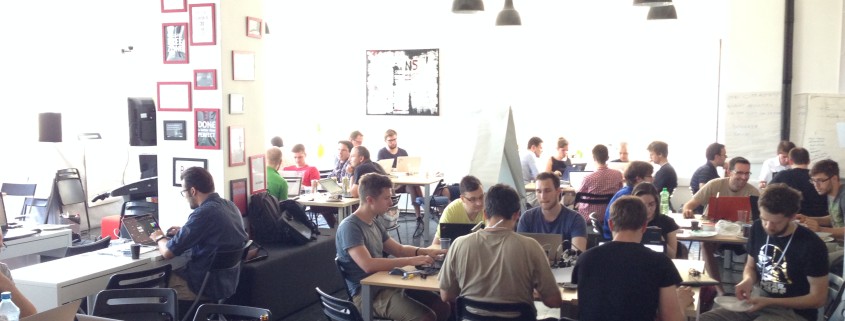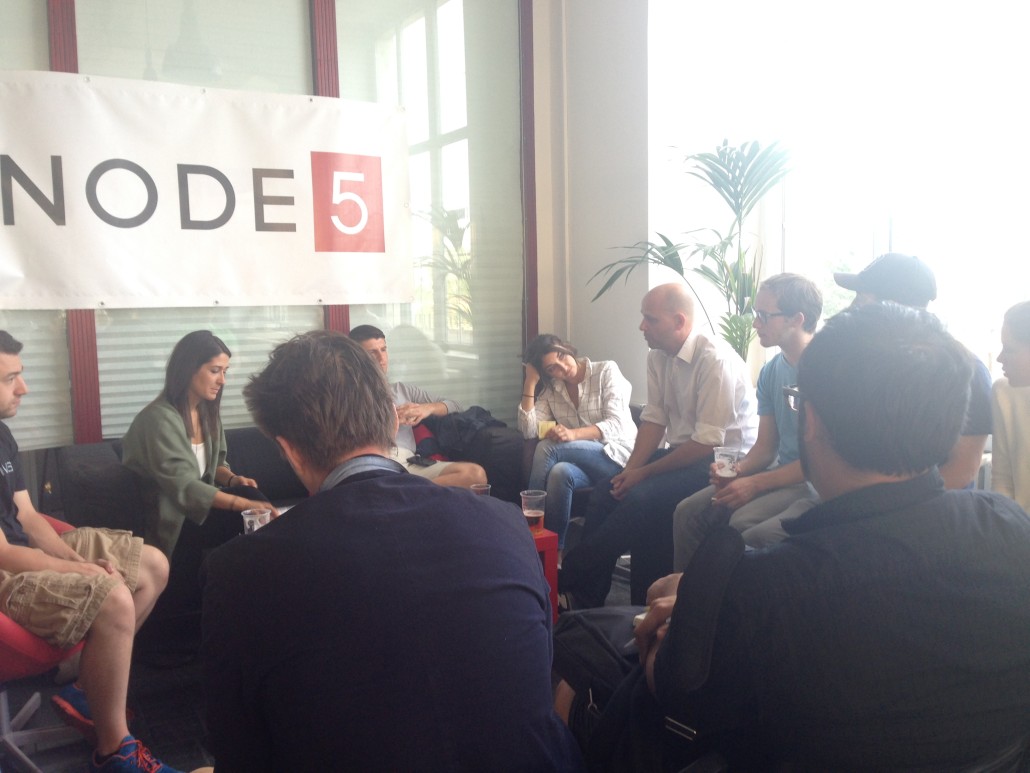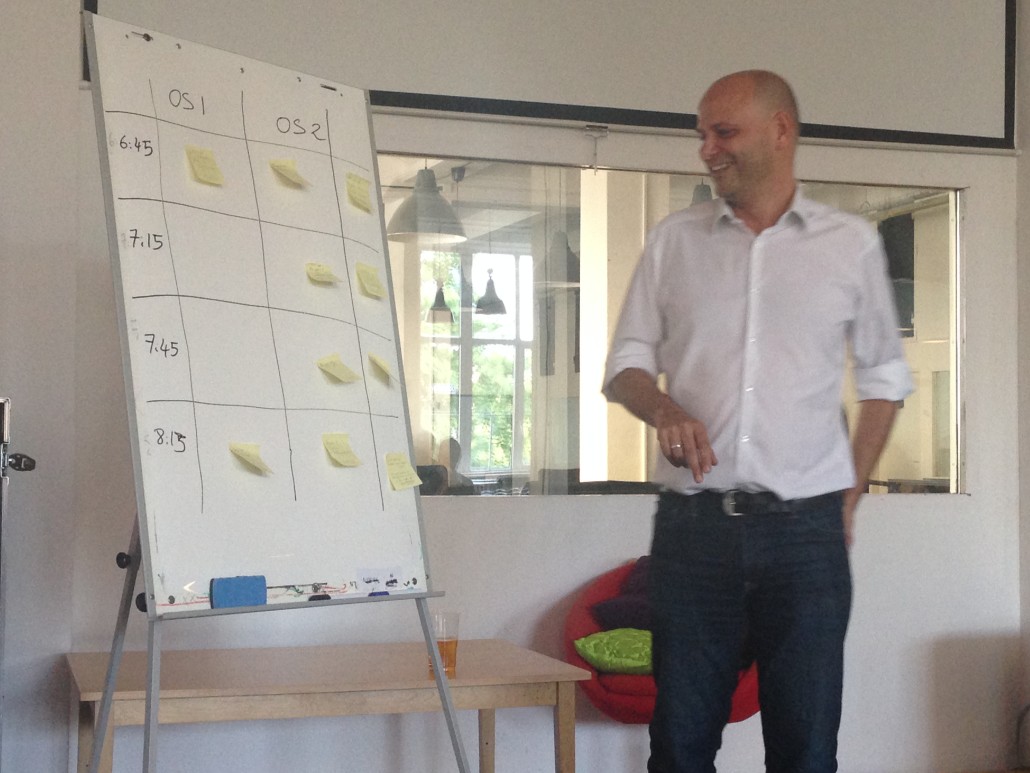StartupYard’s 3rd Unconference: Remote Year, Work/Home Balance, and Blogging
Wednesday night, at Node5, StartupYard hosted our 3rd “Unconference.”
Unconferencing is an alternative take on a conference in which the participants help shape the talks and sessions offered.
An Unconference differs from a traditional conference or set of workshops, chiefly in that none of its content is planned or scheduled ahead of time. Instead, the content of workshops is decided spontaneously, by whomever is in attendance, and is interested in contributing.
#Unconference evening at #Node5 with @remoteyear and @StartupYard pic.twitter.com/ukxuPch3BF
— NODE5 (@TheNode5) June 17, 2015
The whole process looks a bit like this:
1. Introduce the format to attendees.
2. Attendees write down a workshop topic they would like to host or to attend on sticky notes.
3. Participants vote on the topics to be included in a series of time slots, with multiple workshops running simultaneously. The total number depends on the space and the number of attendees.
4. The moderator proposes a schedule of the events, striking a balance between topics, and not putting the most popular workshops in competition.
5. Attendees suggest changes, and the conference kicks off, with the topic owners either presenting themselves without preparation, or asking for others to present on the topic they’ve proposed- in some cases, workshops become idea-sharing and brainstorming meetings.
Remote Year
This unconference was presented in cooperation with Remote Year, an interesting organization from the US. Remote Year collects a group of people who work independently or remotely, and offers them a once in a lifetime chance: to work in a different city, every month, for an entire year.
The object is to get to know their fellow travelers (people from around the world, not just the US), and experience life in a huge range of cities around the world, while continuing to work remotely. The organization plans and organizes all travel, accommodations, and workspaces for the workers, as well as occasional events, such as our Unconference.
The group we met, about a third of Remote Year’s 75 current members, were engaged and interesting. I’d love to hear more of their feedback about how Remote Year works for them, but they’re just at the start of their journey. They’ll soon be moving on to Slovenia, then to Croatia, Turkey, and later to Asia and South America, visiting Malaysia, Thailand, Vietnam, Japan, Argentina, Chile and Peru.
Remote Year doesn’t seem cheap, at $24,000 for the full year (paid twice a month), however, considering that this is probably competitive with rents in many American cities, and it represents travel and accommodation expenses, it might not be as expensive as it seems.
Topics
There were a wide range of topics, including “video games as a business,” and “monetization of mobile apps: subscription vs. one-time payments.” But as I often do, I gravitated to soft skills topics, so these are the sessions I’ll talk about here.
Session 1: Understanding Neuroscience for Sales and Pitching
Cedric Maloux, StartupYard’s Managing Director, has given this presentation a few times, and it is always interesting. He based his talk on two books: Pitch Anything, by Oren Klaff, and Influence: the Psychology of Persuasion, by Robert B. Cialdini.
He talks about the concept of human evolution being related to “three brains:” the “reptilian brain,” the “middle brain” and the “thinking” or intellectual brain. One brain has been built “on top” of the other through the course of human evolution.
The important insight here is that while we think of ourselves as intellectual beings who make rational decisions, we in fact base many of our actions and thoughts on more primal, less rational instincts. The reptilian brain assesses the world according to the most basic terms of survival, more crudely put: “can I eat it, can it eat me, or can I have sex with it?”
Advertisers have long known that fear, aggression, and reproduction are the most powerful drivers of human action. But that insight shouldn’t be limited to advertising. So Cedric talks about how to appeal to the “reptilian” brain in all of us: by evoking these same feelings, either with images in presentations, certain words, or ideas that appeal to our basic survival instincts.
At the same time, Cedric highlights the “power of because.” Also long known to marketers, psychologists, and salespeople, research dating back to the 1970s shows that by supplying reasons for our need to do something, or for our need for others to do something, we can influence them to go along with us at a very high rate.
The classic experimental proof involves a woman asking to cut in line at a copy machine, but there have been variations that included people asking for seats on metro cars, and other situations. Research shows that when you ask to cut in line at a copy machine, even giving a bogus reason like “I have 5 pages,” you only stand a 60% chance or so of getting what you want. However, when you state the reason more clearly, using “because,” you can reach a 94% rate of assent from subjects. If you ask: “can I cut in line because I’m in a rush?” you’re over 50% more likely to be allowed to do so.
Interestingly, the increase in acceptance also applies even if no new information is added. So, for example, if the “I have 5 pages,” is reworded to “because I have 5 pages,” the results are the same as when giving a valid reason.
These experiments also showed that the power of because extended even to unreasonable requests, although its power diminishes as the request becomes more unreasonable. While a person with 5 pages could get up to 94% acceptance, a person with 20 pages might get only 42%, but that would still be almost double the amount that they could get without a “because.”
Work/Home Balance
A topic of interest to me as a newly minted dad who annoys his co-workers with pictures of his kid, this was more of a discussion group. The StartupYard team, along with the Node5 team and a few members of Remote Year got together to discuss the issue of balancing life and work, or, for some, the concept of there being a difference between life and work.
This session focused on two things: the problem of balance and priorities, and the issue of extraversion vs. introversion.
We first discussed the “four burners theory,” a concept popularized the American writer David Sedaris, which poses the problem as one of priorities. A balanced life has 4 burners, as on a stove. One is for family, one for friends, another for health, and the fourth for work. It being difficult or impossible to cook on four burners simultaneously, a successful person will usually choose to remove one. For example, a person who values their work and family, must then choose to abandon either their health, or their friends.
It stands to reason that a successful career, a solid family, and a healthy lifestyle doesn’t allow someone to keep up friendships, which involve nights out, hobbies, and other time consuming activities. At the same time, a person may choose to have a great career, and time to go to the gym and eat healthy, but must then choose between spending time with their friends, or going out on dates in the hope of finding a mate.
Again, a person may choose to have a family, have friends, and be healthy, but must then spend less time focusing on a career and making money.
Moreover, the theory goes that a person who wishes to be *really* successful, must only use two burners. You can be very healthy and have a great career, you can be an amazing friend and parent, or you can have a great family and an ambitious career, but you can’t perform at the top of your game in three areas at once.
While we all shift our priorities over time, I found some truth in this framework. I have sacrificed mostly friendships as I have transitioned to my interest in my family. My wife has stayed out of the workforce to raise our son, but has been able to maintain friendships and a healthy lifestyle. As some in the discussion pointed out, these changes are cyclical, and they need not be permanent. Roles can switch, and the needs of families change over time, as kids grow up and look after themselves.
We also discussed the concept of the “outgoing extrovert.” While Petra of Node5 described herself as an extrovert because of her ability to talk to groups and be outgoing, she also described her need to be alone with her own thoughts. It was pointed out that she might not be extroverted, but rather outgoing. Cedric too, pointed out that his public speaking ability and his career working with so many people was in fact a defense that he has built up because of his introversion, and not because he is extroverted.
On the other hand, members of the discussion who really are extroverts talked about how difficult it is for them to pass up spending time with their friends, while the extroverts couldn’t easily sympathize with the dilemma that the extroverts face; they would almost always rather be on their own. For the extroverts, not being among their friends was a draining experience, rather than a relaxation.
These are the sort of layered and spontaneous discussions that a really good Unconference can generate: when’s the last time you talked about your emotional needs at a business conference?
Blogging and Writer’s Block, and “Brand Building”
Finally, I participated in a discussion about blogging. Something I’ve come to think a lot about in the past few years.
As many of the attendees were about to spend the next year traveling the world, many were thinking of writing “travel blogs.” The problem, it seems, is that many didn’t have a sense of the value of that kind of blogging. Why do it? Who is it for? How to start?
In writing, we often talk about “writer’s block.” While many people think of this as an issue of not knowing what to write, it’s actually more complicated. “Writer’s block,” is the dreaded feeling that writers have when they are unable, or don’t know how, to start writing, even when they know what they would like to write about.
A blank page spreads out before the writer like a barren desert, and the enormity of having to fill it with good ideas is frightening. This stops many people from writing, blogging, or doing many other creative activities.
I suffer this existential fear all the time, particularly when my writing is not work related. But writers can learn tricks to overcome the problem.
My trick, which works better for me in blogging that it does in longer works, is to always keep the problem in mind when I write. Just as we work with our startups to focus on the problem they are solving for their customers, and the unique value they are providing to overcome customer pain, I approach writing this blog in the same way.
What problem can I solve for our readers, by writing about something? It can be a basic problem, such as our readers not knowing about something they should know about. Or it can be more complex, such as the piece we posted earlier this week about StartupYard’s deeply held values, and how they differ from what people might expect. The problem then would be that people see something a certain way, and the writer doesn’t. So the writer must express his or her view, and persuade or at least inform people of their opinions and views.
If you aren’t writing to address a problem, or a lack of something, then you aren’t writing for anyone. If you aren’t writing for anyone, then why are you writing? Of what value is what you write?
While members of the discussion talked about having a blog in order to “build a personal brand” (an already overhyped concept on its own), the problem remains. A brand is built around values, and you have to have values (and thus opinions), in order for your brand to have any meaning.
We are all aware of this subliminally, if not intellectually.
Think of a few famous brands, and you will be able to define their values fairly clearly. McDonald’s? Family, “Americanization,” entrepreneurialism, convenience, and comfort. You may see other positive or negative connotations in the McDonald’s brand, but you’ll recognize that the brand communicates those concepts consistently. Apple? Cutting edge design, ease of use, and high-end mass consumerism. Whether you hate or love Apple, you can recognize that these are its core values, whether they are successful or not.
In “building a brand,” a blogger, just like a corporation, has to establish what the brand is intended to convey. Otherwise, readers will be less than charitable with their own interpretations. And the best way to convey your values is to talk about them passionately- to argue for them, and to make the discussion about them, rather than about yourself, your needs, or your idea of what your “brand” is all about.
If you can do that consistently, as I hope this nearly 2500 word blog post (written in less than 2 hours) will show, writer’s block may be the least of your problems as a blogger.







